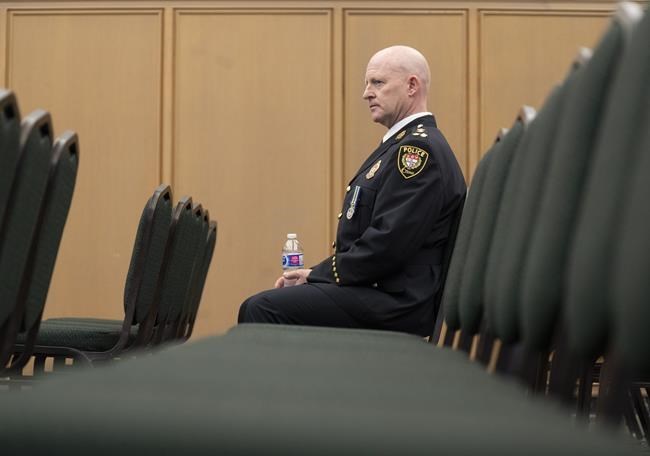OTTAWA — In the days leading up to the mass protest in Ottawa last winter, police didn't have intelligence suggesting the "Freedom Convoy" would use local citizens as a "leverage point" and didn't factor in the risks the convoy posed to the community, interim police chief Steve Bell said Monday.
Bell was on the stand all day at the Public Order Emergency Commission, which is probing the federal Liberal government's use of the Emergencies Act to clear protesters.
He was a deputy chief and in charge of intelligence when the convoy began but was elevated to interim chief in mid-February after Peter Sloly resigned.
Bell testified that based on their intelligence, police were expecting a large convoy of peaceful protesters to roll into the city, and leave after several days.
He said that is not what happened.
“I believe we were unprepared for what transpired,” Bell said.
He later added that he felt the "Freedom Convoy" created "unprecedented circumstances" for the police after it arrived in Ottawa.
Commission lawyer Frank Au spent the morning questioning Bell about police intelligence ahead of the protest, including a threat assessment police prepared for the convoy's expected arrival in Ottawa on Jan. 29.
The commission was also shown an email later Monday from the head of the RCMP telling the federal government, "we have not yet exhausted all available tools," hours before Prime Minister Justin Trudeau invoked the Emergencies Act.¬Ý
In the email sent Feb.14 to Public Safety Minister Marco Mendicino's chief of staff, Mike Jones, shortly before 1 a.m., Brenda Lucki said criminal charges could be laid under existing Criminal Code offences happening at the "Freedom Convoy" protests.¬Ý
The commission heard last week that a local hotel association warned the City of Ottawa and police before protesters arrived that they were booking rooms for 30 days.¬Ý
The Jan. 29 threat assessment, prepared by Ottawa police’s security intelligence section, noted an increase in social media posts suggesting violence should be used if the government does not acknowledge the convoy. But it also says no threats or credible plans had been identified.
"Convoy members appear to be stocking up on food and supplies which could indicate they have long term plans to stay in Ottawa," the report says. It also added that emotions at the demonstration may run high and traffic could disrupted.¬Ý
But Bell testified the available intelligence before protesters arrived showed the convoy would largely be a three-day event, with only a small number staying longer than one weekend.¬Ý
He also told the commission that intelligence said there were a lot of people involved in the convoy but that they had been "extremely lawful," as they travelled towards Ottawa.
"They were people moving across the country determined to be heard, but they were peaceful," Bell testified. "They indicated that their intention was to be peaceful when they got here."
Bell said that's not what ultimately happened.
During his testimony, Bell repeatedly said the three-week long protest inflicted "violence," "harm" and "trauma" onto residents in the city.¬Ý
Earlier testimony from some downtown residents and local city councillors painted a picture to the commission of a lawlessness existing in the downtown during the subsequent weeks after protesters arrived.¬Ý
Witnesses testified to living with an unending honking of horns and city officials spoke about how the blockade disrupted many services and closed businesses.¬Ý
"They were suffering," Bell said. "It's not just tooting a little horn," adding the hundreds of trucks also sat idling, releasing plumes of diesel.
Bell testified Monday that nothing in the intelligence warned that protesters would end up using Ottawa residents as collateral damage. He defended the intelligence gathering and police planning at that time by saying the force was used to managing large protests, but didn't have experience working with a group like convoy organizers.¬Ý
"There's nothing that indicates that the protesters are going to use the citizens of our community as the leverage point to have their voices heard," he said of the police intelligence.
Bell said it was difficult for the police liaison team to maintain communications with the protesters because there were a number of different leaders.
He also said based on intelligence police had before demonstrators first arrived, police didn't feel they had a legal right to deny them access to the city core.¬Ý
A legal opinion on that subject prepared ahead of the protest said “where individuals or groups do not hinder or obstruct vehicular traffic for extended periods, they maintain the right to protest so far in so that it does not engage or entail unlawful conduct.”
But he said police learned a lot during the convoy and as proof pointed to the "Rolling Thunder" demonstration staged by similar groups several months later.
During that protest, police prevented vehicles from entering downtown, and it did not result in a prolonged blockade.¬Ý
"A truck isn't a protected entities under the Charter of Rights and Freedoms," Bell said Monday. "People are."
It is the seventh day of testimony at the inquiry, which is set to last six weeks. Thus far witnesses have painted for the commission a picture of chaos and confusion among levels of government and police forces, as officials determined how to respond to the situation.
It has also revealed there was disagreement over the extent to which there was a serious threat of extremist violence among protesters.
This report by The Canadian Press was first published Oct. 24, 2022.
Stephanie Taylor and David Fraser, The Canadian Press




